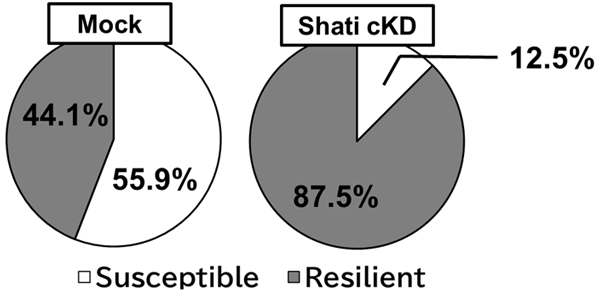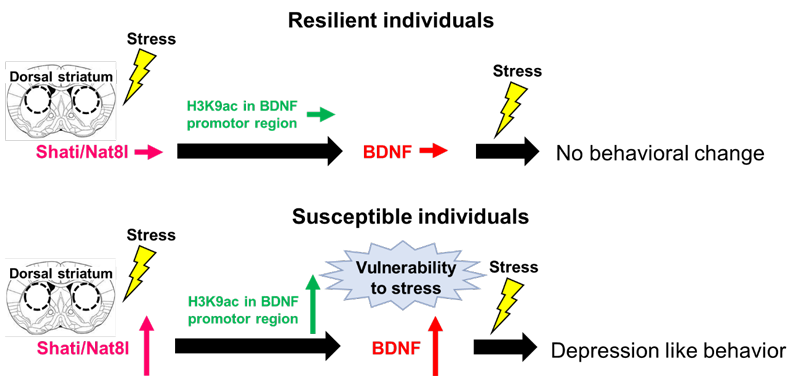Striatal Shati/Nat8l–BDNF pathways determine the sensitivity to social defeat stress in mice through epigenetic regulation
Neuropsychopharmacology (2021)
DOI: 10.1038/s41386-021-01033-2
A novel mechanism for regulating the stress sensitivity underlying depression pathogenesis
The global number of patients with depression increases in correlation to exposure to social stress. However, existing antidepressant drugs require long periods before the effects are seen, and approximately 30% of depression patients have resistance to treatment with antidepressants. For these reasons, discovering novel targets of antidepressants and establishing therapeutic strategies that work for all patients is desired.
Stress is closely related to depression, and depression onset is triggered by stressful environments. Vulnerability to depression onset is caused by depressive episodes such as stress, thereby leading to depression onset in response to even mild stress. However, not all individuals are vulnerable to depression onset, as some remain resilient. Mice exposed to the same stressful conditions can also be classified as either stress-susceptible (those that show depressive behaviors) or resilient (those that do not). Revealing the underlying regulatory mechanisms of stress sensitivity could offer insight in understanding and developing treatments for depression.
We previously found that striatal Shati/Nat8l, a mental disorder-related gene, was increased in a depression mouse model. In this study, mice were exposed to repeated social defeat stress (RSDS), and we found that Shati/Nat8l in the striatum increased in the stress-susceptible mice, but not resilient mice. We generated Shati/Nat8l conditional knockdown in the dorsal striatum of mice (Shati cKD mice) using the Cre/loxP system for investigation of whether Shati/Nat8l in the striatum is involved in determining stress resilience. While control mock mice with RSDS showed strong suppression of social interaction, the Shati cKD mice with RSDS did not show a lower social interaction time. Furthermore, the ratio of stress resilience was increased four-fold by knockdown of Shati/Nat8l in the dorsal striatum (Figure. 1), suggesting the involvement of Shati/Nat8l in stress sensitivity in the dorsal striatum.

Figure. 1. The ratio of stress-susceptible and resilient mice after RSDS.
We also found that BDNF in the striatum was increased in the stress-susceptible mice, but not resilient mice. We assessed the effect of ANA-12, a noncompetitive antagonist of the BDNF-specific receptor tropomyosin-receptor-kinase B (TrkB) to investigate the involvement of striatal BDNF elevated by RSDS in stress sensitivity. The blockade of BDNF signaling in the dorsal striatum by ANA-12 induced resilience to RSDS.
Next, we investigated the functional relationship of stress sensitivity between BDNF and Shati/Nat8l in the dorsal striatum since both striatal Shati/Nat8l and BDNF regulate stress sensitivity. BDNF levels displayed a positive correlation to Shati/Nat8l levels after social defeat stress, and the increase of BDNF by RSDS was suppressed in Shati cKD mice. These results indicate that striatal BDNF is a downstream protein of Shati/Nat8l.
To investigated the regulation mechanisms of BDNF by Shati/Nat8l in the dorsal striatum of stress-susceptible mice, we focused on epigenetic mechanisms, including acetylation of histones. Histone acetylation levels in the BDNF promotor regions in the stress-susceptible mice were significantly increased compared with stress-naive mice and resilient mice. This finding is consistent with the increased BDNF levels in the dorsal striatum of susceptible mice after RSDS because histone acetylation generally enhances gene transcription. Furthermore, elevation of histone acetylation levels in the BDNF promotor region after RSDS was abolished by striatal knockdown of Shati/Nat8l, suggesting that BDNF levels in the dorsal striatum were controlled by Shati/Nat8l via histone acetylation.
In this study, we showed that the decrease of striatal BDNF is an appealing therapeutic strategy for depression. However, it is difficult to directly target BDNF itself for treatment in depression because BDNF also has antidepressant effects in other brain regions, including the mPFC and hippocampus. Considering that the Shati/Nat8l-BDNF pathway specifically works to the dorsal striatum in response to stress, modulation of Shati/Nat8l would allow BDNF to be striatum-specifically reduced. Reduction of damage from stress would synergize therapeutics for depression and accelerate the recovery of its pathology.
Taken together, our results demonstrate that the Shati/Nat8l-BDNF pathways in the dorsal striatum determine sensitivity to stress in the pathogenesis of depression via epigenetic regulation (Figure. 2). We have provided the first evidence supporting the role of striatal BDNF in depression pathology. The present results further indicate that Shati/Nat8l-BDNF signaling in the dorsal striatum should be considered a potential new target for treating depression and might establish therapeutic strategies for all patients, including those with treatment resistance.

Figure. 2. A schematic representation of the mechanism for regulating the stress sensitivity.
Hajime Miyanishi, Shin-ichi Muramatsu & Atsumi Nitta
Striatal Shati/Nat8l–BDNF pathways determine the sensitivity to social defeat stress in mice through epigenetic regulation
Neuropsychopharmacology (2021)

